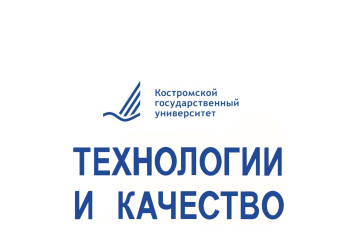- 3
- MODERN TECHNOLOGIES AND TOOLS AIMED AT IMPLEMENTING THE PRINCIPLES OF SUSTAINABLE DEVELOPMENT IN THE TEXTILE AND LIGHT INDUSTRY
- Irgasheva A. Sh., Chagina L. L. Modern technologies and tools aimed at implementing the principles of sustainable development in the textile and light industry. Technologies & Quality. 2025. No 2(68). P. 15–22. (In Russ.). https://doi.org/10.34216/2587-6147-2025-2-68-15-22.
- DOI: https://doi.org/10.34216/2587-6147-2025-2-68-15-22
- УДК: 677.017
- EDN: MZXRUZ
- Publish date: 2025-05-20
- Annotation: The article is devoted to the analysis of modern equipment used for processing textile waste, which is one of the key tasks in the context of sustainable development and of reducing the environmental footprint of the fashion industry. Special attention is paid to the functional features of the equipment, its efficiency, energy intensity and the possibility of integration into production cycles. The article highlights the importance of introducing such technologies to reduce waste disposal and consumption of primary raw materials, and transition to circular economy. The directions of textile recycling development and new trends that may change the approach to waste disposal are also considered. The paper highlights the importance of joint cooperation between fashion brands, scientific institutes, and equipment manufacturers for the introduction of responsible manufacturing in the textile industry.
- Keywords: waste, recycling, closed-loop technologies, equipment, textile and light industry, sustainable development, utilisation
- Literature list: 1. Sustainable development goals. URL: https://www.un.org/sustainabledevelopment/ru/sustainable-development- goals (accessed 22.04.2025). 2. Baranova A. F., Mamedov S. N., Pogodina I. V. Minimizing the amount of waste generated by the textile industry. Izvestiya vysshih uchebnyh zavedenij. Seriya Teknologiya Tekstil’noi Promyshlennosti [Proceedings of Higher Educational Institutions. Series Textile Industry Technology]. 2019;5(383):283–287. (In Russ.) 3. Golov R. S, Kostygova L. A, Smirnov V. G. The use of textile waste: an analysis of the state and prospects of development. Izvestiya vysshih uchebnyh zavedenij. Seriya Teknologiya Tekstil’noi Promyshlennosti [Proceedings of Higher Educational Institutions. Series Textile Industry Technology]. 2021;5(395):241–250. (In Russ.) 4. Gavrilyuk Ye. Yu., Azanova A. A., Mustafina R. R., Suhova A. A. Polymer-fiber composites based on waste rubberized fabrics. Izvestiya vysshih uchebnyh zavedenij. Seriya Teknologiya Tekstil’noi Promyshlennosti [Proceedings of Higher Educational Institutions. Series Textile Industry Technology]. 2024;6(414):295–299. (In Russ.) 5. Kayumova R. F., Nevolyani Yu. M. Ways to use textile waste using the example of interstitial attacks. Izvestiya vysshih uchebnyh zavedenij. Seriya Teknologiya Tekstil’noi Promyshlennosti [Proceedings of Higher Educational Institutions. Series Textile Industry Technology]. 2023;1:108–113. (In Russ.) 6. Kasheyev O. V., Usik S. P., Vingert A. I. Responsible consumption as a new cultural paradigm of modern society. Vestnik Slavyanskih kultur [Bulletin of Slavic Cultures]. 2021;61:127–135. (In Russ.) 7. Nurjasarova M. A., Sarttarova L. T., Dikenova D. B. Principles of implementing lean manufacturing in garment enterprises. Izvestiya vysshih uchebnyh zavedenij. Seriya Teknologiya Tekstil’noi Promyshlennosti [Proceedings of Higher Educational Institutions. Series Textile Industry Technology]. 2019;5(383).187–191. (In Russ.) 8. Shushunin D. N., Kruglov A. V., Zyablov V. A, Gruzinseva N. A. The use of lean production tools on the example of the organization of the warehouse of the finishing production of a textile enterprise. Izvestiya vysshih uchebnyh zavedenij. Seriya Teknologiya Tekstil’noi Promyshlennosti [Proceedings of Higher Educational Institutions. Series Textile Industry Technology]. 2024;5(413):20–24. (In Russ.) 9. Gerasimovich E. M. Problems and prospects of recycling textile industry waste. Aktualnye problemy gumanitarnyh i yestestvennyh nauk [Current problems of the humanities and natural sciences]. 2016. № 5. URL: https://cyberleninka.ru/article/n/problemy-iperspektivy-vtorichnoy-pererabotki-othodovtekstilnoy-promyshlennosti (accessed 24.04.2025). (In Russ.) 10. Bekmurodova О. А. K., Ilyushina S. V., Minyazova А. N. Problems of waste processing in the textile and light industry. Arhivarius. [Archivist] 2016;10(2). URL:https://cyberleninka.ru/article/n/problemy pererabotki-othodov-tekstilnoy-i-legkoypromyshlennosti (accessed: 24.04.2025). (In Russ.) 11. Gardetti M. A. Introduction and the concept of circular economy. In: Muthu S. S. ed. Circular Economy in Textiles and Apparel. Cambridge, Woodhead Publishing, 2018. P. 1–11. 12. De Jesus A., Mendonça S. Lost in Transition Drivers and Barriers in the Ecoinnovation Road to the Circular Economy. Ecological Economics. 2018;145:75–89. 13. Irgasheva A. Sh., Chagina L. L., Trynova A. V. Prospects for the introduction of closed-loop systems in the fashion industry. Izvestiya vysshih uchebnyh zavedenij. Seriya Teknologiya Tekstil’noi Promyshlennosti [Proceedings of Higher Educational Institutions. Series Textile Industry Technology]. 2023;3(405):5–14. (In Russ.) 14. Todeschini B. V., Cortimiglia M. N., Callegarode-Menezes D., Ghezzi A. Innovative and sustainable business models in the fashion industry: Entrepreneurial drivers, opportunities, and challenges. Business Horizons. 2017:759–770. 15. SGS, Jeanologia Partner to make laser finishing more efficien. Sourcing Journal. URL: https:// sourcingjournal.com/denim/denim-sustainability/sgs-jeanologia-laser-finishing-bluescan-advanced-light-sensitive-fabric-test-345283 (accessed 10.04.2025). 16. Sandvik I. M., Stubbs W. Circular fashion supply chain through textile-to-textile recycling. Journal of Fashion Marketing and Management. 2019;23(3):366–381. 17. Fung Yi. N., Choi Ts. M., Liu R. Sustainable planning strategies in supply chain systems: Proposal and applications with a real case study in fashion. Production Planning & Control. 2020;31(2):883–902. 18. Chemical sorting can be used to isolate polyester from textile waste. URL: https://www.waste.ru/modules/news/article.php?storyid=5921 (accessed 8.04.2025). (In Russ.) 19. Irgasheva A. Sh., Chagina L. L., Kuznetsov A. A. Recycling of denim product waste in the context of the transition to rational production and consumption models. Innovations in textiles, clothing, and footwear (ICTAI-2023) [Innovations in Textiles, Clothing, and footwear (ICTAI-2023)]. Materials of the reports of the international scientific and technical conference, Vitebsk, 09–10 ноября 2023 года. Vitebsk, Vitebsk St. Technol. Univ. Publ., 2024. P. 40–44. (In Russ.) 20. Sacaluga A. M., Bellas R., Pardo Ju. E., Paz E. Traceability management systems and capacity building as new approaches for improving sustainability in the fashion multitier supply chain. International Journal of Production Economics. 2019;217(5):143–158. 21. Koszewska M. Circular Economy-Challenges for the Textile and Clothing Industry. Autex Research Journal. 2018;18(4):337–347.



